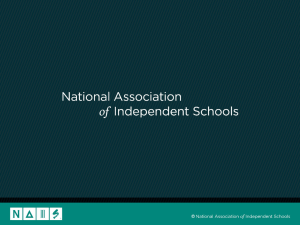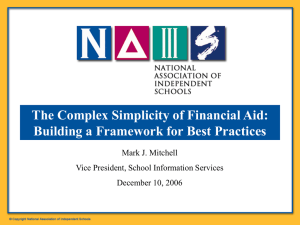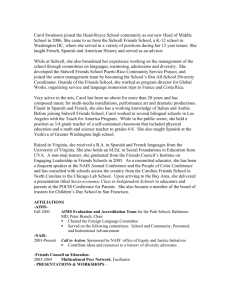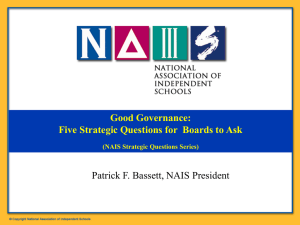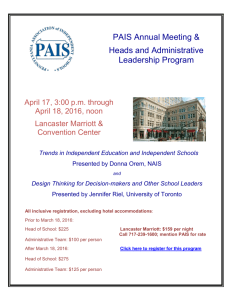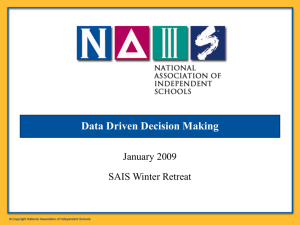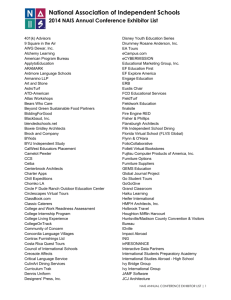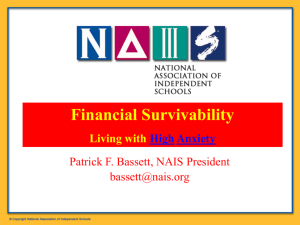CASE/NAIS 2006
advertisement
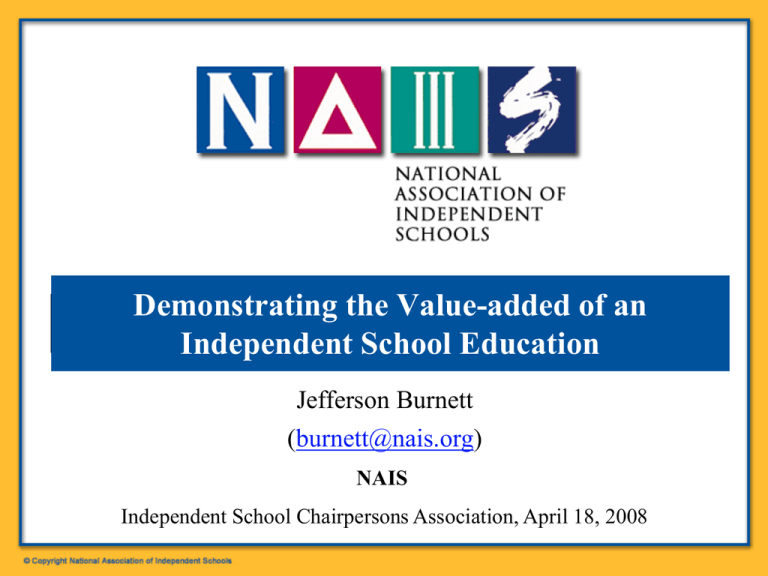
Demonstrating the Value-added of an Independent School Education Jefferson Burnett (burnett@nais.org) NAIS Independent School Chairpersons Association, April 18, 2008 Overview Looking at Our World from the Outside/In, How Do External Factors Shape Our Environment, Experience, and Reality? How do these relate to/connect with a school’s mission, what it does to implement the mission, the outcomes…its value-added? How do we manage those external factors to ensure the long-term institutional sustainability? Our World (External Factors) Economy Competition Demographics Public Perceptions of Independent Schools What This Tells Us and How We Enhance Our Value-added Case studies Relevancy Pop Quiz Pop Quiz Question My family is facing #1 a decision about my…son. He is in a A parent is shopping for schools,elementary stops by to school, see you,and and he’s asks G/T class in our neighborhood you this question: What is your school’s value-added? been offered admission at a…local private school…Although Pop Quiz Questionwe #2 realize that there are many factors that A go parent shopping for schools and stops by choices, a public magnet can intoisthe plus/minus columns of both we were /charter/virtual and asks What on is your wondering how school to evaluate the this twoquestion: based strictly school’s value-added? academic rigor…how can we form an opinion of which is “better” academically? AK from VA (WPost Feb option Pop Quiz Question #3 How do the response differ? 08) Pop Quiz Question #4 Is your school’s value-added proposition good enough in today’s climate? Our World: Trends The Economy The Economy Federal Reserve Chairman Ben S. Bernanke acknowledged for the first time that a U.S. recession is possible because homebuilding, employment and consumer spending will deteriorate. ``It now appears likely that real gross domestic product will not grow much, if at all, over the first half of 2008 and So:could What the implications of told a bad economy for evenare contract slightly,'' Bernanke Congress's Joint Economic Committee today. schools? (4/2/08 Bloomberg) independent Merrill Lynch & Company, the investment bank, posted a loss for on Thursday – Job layoffs = fewer applicants, more requests and announced that it would lay off 10 percent of its work force or about aidof the year. (4/17/08 NYT) 4,000financial jobs by the end – HigherAirlines energy costs = increased Continental posted a first-quarter lossoperational on Thursday, costs, while a higher rival, Southwest Airlines, said that its profit fell sharply in the period. Both tuition or fewer services carriers cited rising fuel costs as the reason for the lower results.Southwest also pulled back on growth plans as a weak economy and record fuel costs took a toll – Inflation = all goods and services increase in price, on the discount carrier.//The parent company of American Airlines, the AMR higherposted tuition or million fewerfirst-quarter services loss as surging fuel prices sent Corporation, a $328 the industry into a downturn (4/17/08 NYT) Not to be depressing, but… – Other… Wall Street analysts are suggesting the breakup of General Electric after an unusual earnings shortfall. 4/17/08 NYT) Economic Trends Tuition increases, income divide • Nationally, median tuition for 1st grade increased 31.3% in inflation-adjusted dollars between 1995-96 and 2005-06, which includes a 16.5% increase between 2000-01 and 2005-06. ~ NAIS Statistics • For 12th grade, median tuition increased 27.6% in the decade between 1995-96 and 2005-06, including a 14.5% increase between 2000-01 and 2005-06. ~ NAIS Statistics • Rich are getting richer…middle class squeezed…what is the middle class? Demo-EcoTrends Disappearing Middle Class Disposable income Parents will ask: are you going to come to my emotional rescue? The Middle Class: Dual Income Family $75,000 ~ “The Middle Class on the Precipice,” Harvard Magazine, February, 2006 Dual vs. single earners NAIS SSS Five Year Trend Parent’s Financial Statement Filers Our World: Trends The Competition The Competition Ok…now be HONEST…what’s your COMPETITION? Online Schooling Grows, Setting OffDiploma a Debate Urban Schools Aiming Higher Than The New York Times (from February 1, 2008) BOSTON At American Excel High School, in South Boston, “Half a — million children take classes online, and many are attending virtual schools that are competing with local teachers do not justpublic prepare students academically fordistricts the public financing.” SAT;forthey take them on practice walks to the building where the SAT will be given so they won’t get lost on the day of the test. (1/18/08 NYT) The Competition Not What Parents Were Expecting Percentage of Students Reporting a B+ or More as Their Current Grade Average 100% 80% 60% Ok…pause…your reactions? Do you think the competition is any good? 54% 50% 69% 53% 51% 43% 40% 20% 0% Independent Schools Hey, this is us! Public Schools Private Religious Public Charter Public Magnet Home School Who are these folk? Source: 2006 Your First College Year (YFCY) Survey , The Higher Education Research Institute (HERI) -UCLA Our World: Trends Demographics Changing School-age Population Source: Projections of Education Statistics to 2015, U.S. Dept. of Education, NCES, September 2006. Forecasted Growth in Population Age 0-17 Years Metropolitan Areas % Growth 2007-2012 Atlanta-Sandy Springs-Marietta, GA 9.63% Dallas-Fort Worth-Arlington, TX 8.74% Canan, NH 6.90% Nashville-Davidson--Murfreesboro, TN 6.69% Washington-Arlington-Alexandria, DC-VA-MD-WV 3.10% Miami-Fort Lauderdale-Miami Beach, FL 2.93% NATIONAL 1.97% Cincinnati-Middletown, OH-KY-IN 0.90% Chicago-Naperville-Joliet, IL-IN-WI -0.01% St. Louis, MO-IL -0.33% Baltimore-Towson, MD -0.73% Philadelphia-Camden-Wilmington, PA-NJ-DE-MD -0.98% New Haven-Milford, CT -1.29% Providence-New Bedford-Fall River, RI-MA -2.04% Boston-Cambridge-Quincy, MA-NH -2.74% Detroit-Warren-Livonia, MI -3.18% San Francisco-Oakland-Fremont, CA -3.33% New York-Northern New Jersey-Long Island, NY-NJ-PA -3.54% Source: NAIS Demographic Center Aging of America Shift in age distribution Population of the United States by Age: 1950-2050 70% 60% 59% 58% 54% 50% 53% 40% 38% 34% 30% 60% 29% 27% 26% 20% 53% 26% 21% 20% 10% 0% 12% 9% 8% 13% 1950 1960 1970 1980 1990 2000 2010 2020 2030 2040 2050 0-19 years 34% 38% 38% 32% 29% 29% 27% 26% 26% 26% 26% 20-64 years 58% 52% 53% 57% 59% 59% 60% 57% 54% 54% 53% 65+ years 8% 9% 9% 11% 12% 12% 13% 16% 20% 20% 21% Source: U.S. Census Bureau, International Data Base-Population Pyramids, http://www.census.gov/ipc/www/idbpyr.html Family Structure In 2003: – 68 percent of children under the age of 18 lived with two married parents (compared to 77 percent in 1980) – 23 percent lived only with a mother – 5 percent lived only with a father – 4 percent lived with neither parent. (U.S. Census Bureau, “America’s Families and Living Arrangements: 2003”) The number of two-parent families is projected to slowly decrease to 23.1 million by 2010. (U.S. Department of Commerce, “Projections of the Number of Households and Families in the United States: 1995 to 2010”) Race and Ethnicity Whites will make up only 58% of those in the 0-24 age range by 2015 (compared with 70% in 1990). (Vernes and Krop, “Projected Social Context for Education of Children: 1990-2015”) Hispanics are expected to nearly double from 12 % in 1990 to 21% in 2015. (Vernes and Krop, “Projected Social Context for Education of Children: 19902015”) Half of all school children will be non-Anglo American by 2025, and half of all Americans will be non-Anglo American by 2050. (Hodgkinson, “Secondary Schools in a New Millennium: Demographic Certainties, Social Realities”) The 65% increase in diverse populations will be absorbed by only 230 counties, with California, Texas, and Florida getting about three-fifths. (Hodgkinson, “Educational Demographics: What Teachers Should Know”) Gen Xers Parents Some characteristics of Gen Xers: – Are children of divorce. 40% have grown up in single parent families. As a result, they want a rich family life. While financial success is important, personal lives take precedence. – Have spent more time watching television than going to school. – Have an unrelenting desire to use and learn more about leading edge technology. – Are procrastinators, postponing commitments in order to continue to evaluate options. – Are a racially diverse group. – Will pick up and leave a job that does not satisfy them. Observations K-12 cohort: slower growth nationally, more certain parts of the country Older citizenry: more grand parents paying tuition, families chipping-in, less inclined to pay more in taxes for public schools? Demographic look: more Hispanic families, higher educational attainment means more and different expectations of schools? Financial picture: larger gap rich and poor, hurting emotional middle class, affordability and value of a private school education? Public Perceptions of Independent Schools What are the elements of a quality school? (general public & high income) Providing a safe environment Employing high quality teachers What do you think are some of the key NAIS Public Opinion Poll 3/November 2006 Maintaining discipline elements of a quality school? Washington, Atlanta, Chicago, San Francisco Keeping students motivated/enthusiastic about learning Parents with school age children/High income Samplings: (150k or more) parents with school age children Climate that says it’s okay to study and excel Preparing students academically for college Encouraging parents’ participation Source: Public Opinion Poll, 2006 Top 10 Characteristics That Affect School Quality - General Public Opinion Random Sample (n=501) 100 94 93 90 89 87 87 87 86 86 85 Percent 80 60 40 20 0 Providing a safe environment Employing high-quality teachers Maintaining discipline Source: Public Opinion Poll, 2006 Keeping students motivated and enthusiastic about learning Supporting a Preparing climate that students says it’s okay academically to study and for college excel Encouraging parents to participate in their child's education Preventing drug and alcohol use Preparing students for life and career in a global economy Attending to the needs of students with learning disabilities Top 10 Characteristics That Affect School Quality - High Income Families Opinions Targeted Sample (n=500) 100 97 97 95 93 91 88 84 84 83 82 Percent 80 60 40 20 0 Providing a safe environment Employing high-quality teachers Supporting a Preparing climate that students says it’s okay academically to study and for college excel #6 Gen Pub #5 Gen Pub Same as Gen Pub Different from Gen Pub Source: Public Opinion Poll, 2006 Keeping Maintaining Encouraging students discipline parents to motivated and #3 Gen Pub participate in enthusiastic their child's about learning education #4 Gen Pub Using computers and other technology to enhance learning Preventing Preparing drug and students for life alcohol use and career in a #8 Gen Pub global economy Gap Analysis Among Targeted Sample Percent Rating as Extremely Important (n=500) Percent Rating Independent Schools As Excellent (n=360) Percentage Gap Between General and Independent School Ranking Attending to the needs of students with learning disabilities 76% 24%* -52% Preventing drug and alcohol use 83% 41%* -42% Employing high-quality teachers 97% 66%* -31% Having students drawn from a range of cultures, races and income groups 53% 24%* -29% Keeping students motivated and enthusiastic about learning 91% 66%* -25% Offering solid programs in music and the arts 76% 57%* -24% Providing a safe environment 97% 74%* -23% Maintaining discipline 88% 65%* -23% Preparing students for life and a career in a global economy 82% 60%* -22% Encouraging parents to participate in their child’s education 84% 64%* -20% Supporting a climate that says it’s okay to study and excel 95% 78%* -17% Ouch! Note: “Extremely Important” represents those respondents answering an 8, 9 or 10 on a 10-point scale where 1 is Not At All Important and 10 is Extremely Important. Note: “Excellent” represents those respondents answering an 8, 9 or 10 on a 10-point scale where 1 is Very Poor and 10 is Excellent. *Indicates a significant difference from the characteristic ranked as important at the 95% confidence level Source: Public Opinion Poll, 2006 Ind Schools vs. Public Schools Look at these numbers: Is this why our new competitors are so attractive? Random Sample 2006 (n=501) 1999 (n=751) Percent Rating Independent Schools As Excellent (n=360) Percent Rating Private, Non-Parochial Independent Schools As Better Than Public Schools Providing a safe environment 52% NA 74 Employing high-quality teachers 47% 47% 66 Supporting a climate that says its okay to study and excel 44% 48% 78 Preparing students academically for college 49% 45% 78 Keeping students motivated and enthusiastic about learning 48% 41% 66 Maintaining discipline 57% 63% 65 Encouraging parents to participate in their child’s education 43% 48% 64 Preventing drug and alcohol use 41% 36% 41 Preparing students for life and a career in a global economy 36% 34% 60 Attending to the needs of students with learning disabilities 29% 24% 24 Giving individualized attention to each child 59% 65% 65 Observations Public thinking: are we offering a product they value; why doesn’t the public know more about us? What This Tells Us and What To Do Key Questions/Issues…How Do You… Assure Product Quality (i.e., are schools doing what they say they do)? [POP3 results] – Accreditation. Is your accreditation process designed to help your school confirm/improve quality? What areas do parents (POP3) and your school think are important markers of a quality education? If aligned with your mission, are you doing them? How? Can you get better? Distinguish from the Competition (i.e., what makes us different from virtual, magnet, charters, etc.)? – Program/Mission/Faculty. What actually does distinguish your school from the high-end magnet, virtual, charter down the road or in the ethers? Can you identify what those characteristics are? Data to back it up? Have you done a comparison? Can you demonstrate whether you are a 21st Century School? The Wisdom of the Crowd What’s on your list of skills and values that we should teach for the 21st C.? The skills of … The values of… Creating the 21st. C. Curriculum The Generative Question: What curriculum will prepare students for the 21st Century? What skills & values will • cross-disciplinary knowledge be required? • communication skills • teamwork • analytical reasoning • real world problem-solving skills • creativity and innovation • facility with the use of ideas and abstractions • self-discipline and organization to manage one’s own work and drive it to successful conclusion • leadership • ethical • respectful Creating the 21st. C. Curriculum Who’s Who of Key Players Key Questions/Issues…How Do You… Articulate your VAP (i.e., how do we demonstrate that we’re worth it?) – Outcomes-based Performance Measurements. How is your school accountable to its students and parents? What is your value-added? How can you demonstrate it? [NAIS Outcomes-based Performance Measurements Initiative/NAIS Survey Builder] O-b PMeasurement Tools Explored by NAIS TOOL ADMINISTERED BY TYPE 1 SAT College Board Standardized Testing 2 High School Survey of Student Engagement (HSSSE) Indiana University Student Survey 3 CIRP Freshmen Survey Higher Education Research Institute (HERI) Student Survey 4 Your First College Year (YFCY) Higher Education Research Institute (HERI) Student Survey 5 College Senior Survey (CSS) Higher Education Research Institute (HERI) Student Survey 6 Measures of Academic Progress (MAP) Northwest Evaluation Association (NWEA) Value-Added Test 7 Measure of Academic Proficiency and Progress (MAPP) Educational Testing Service (ETS) Value-Added Test 8 College and Work Readiness Assessment (CWRA) Council for Aid to Education (CAE) Value-Added Test 9 College Placement Study Nat. Assoc. of Independent Schools (NAIS) Institutional Effectiveness Survey 10 Alumni Assessment Survey Nat. Assoc. of Independent Schools (NAIS) Institutional Effectiveness Survey 11 Parent Satisfaction Survey Nat. Assoc. of Independent Schools (NAIS) Institutional Effectiveness Survey 12 SSATB Secondary School Admission Test Board Standardized Testing 13 Data Collection of School Outcomes National Association of Independent Schools (NAIS) School Ratios 14 Accountability Templates Nat. Assoc. of State Univ. and Land-Grant Colleges (NASULGC) Nat. Assoc. of Independent Colleges and Univ. (NAICU) Templates HSSSE—Sample Test Items MAP CWRA NAIS Survey Builder NAIS Survey Builder U-CAN/Dept of ED Key Questions/Issues…How Do You… Know Your Marketplace/Enhance School Marketing (i.e., who we are and what we do) – Marketing. What do you know about trends nationally, regionally, locally? Are you tracking the demographics? [NAIS Demographic Center] What are your messages? How are you getting them out there? [NAIS Advocacy Resources] Advocacy Materials/Demographic Centre DEMOGRAPHIC CENTER Basic Reports 1. They include variables such as school population, families with children by income, race/ethnicity, and educational attainment 2. Types of reports: – Summary Reports – Detailed Reports – Multiple Area Reports Select any of the NAIS Reports Select the area you want to study Press the "Create Report" button Select any of the NAIS Reports Press the ‘Create Table’ button to display your report Case Study I: Changing Gender Trends What strategic questions should the school administration ask? What percentage of all girls would we need to attract to survive? Is that doable? An elementary girls’ school in Philadelphia is just starting a Do we consider going coed? Or merging with strategic visioning process. It goes to the Demographic Center another girls’ school? and sees this. If not, what financial planning do we need to do to help us weather the downturn? Can we work with the local businesses and the chamber of commerce to attract new families to the area? Case Study II: Changing Ethnicity Trends What strategic questions should the school administration ask? – Given the demographic changes, what are the implications A school in San Antonio, Texas, finds that the population of of these changes? people of color in its area is growing rapidly. The school – What are the key characteristics that parents of color are currently hasfor 10% color. looking in astudents school? of Does the school highlight these characteristics in its messages? – What communication channels should the school use to reach out to the people of color in its community? Should the school include other languages in its communications with parents? Strategic Questions What does my five year economic picture look like? – If I do nothing, where will I be? – How dependent is my school on a steady funnel of applicants? – How dependent is my school on full pay families? Can my school stay exactly the same in this market or will it need to be modified in some ways? How will the trend data inform my decision making? Why is this Relevant to You? Key role of Board Chairs, Boards, and Heads in setting institutional direction and ensuring long-term viability Important to be aware of those external factors that affect your school’s sustainability Essential to use available tools and resources to engage in long-term strategic thinking, visioning, and planning We need to be adept and adaptable
